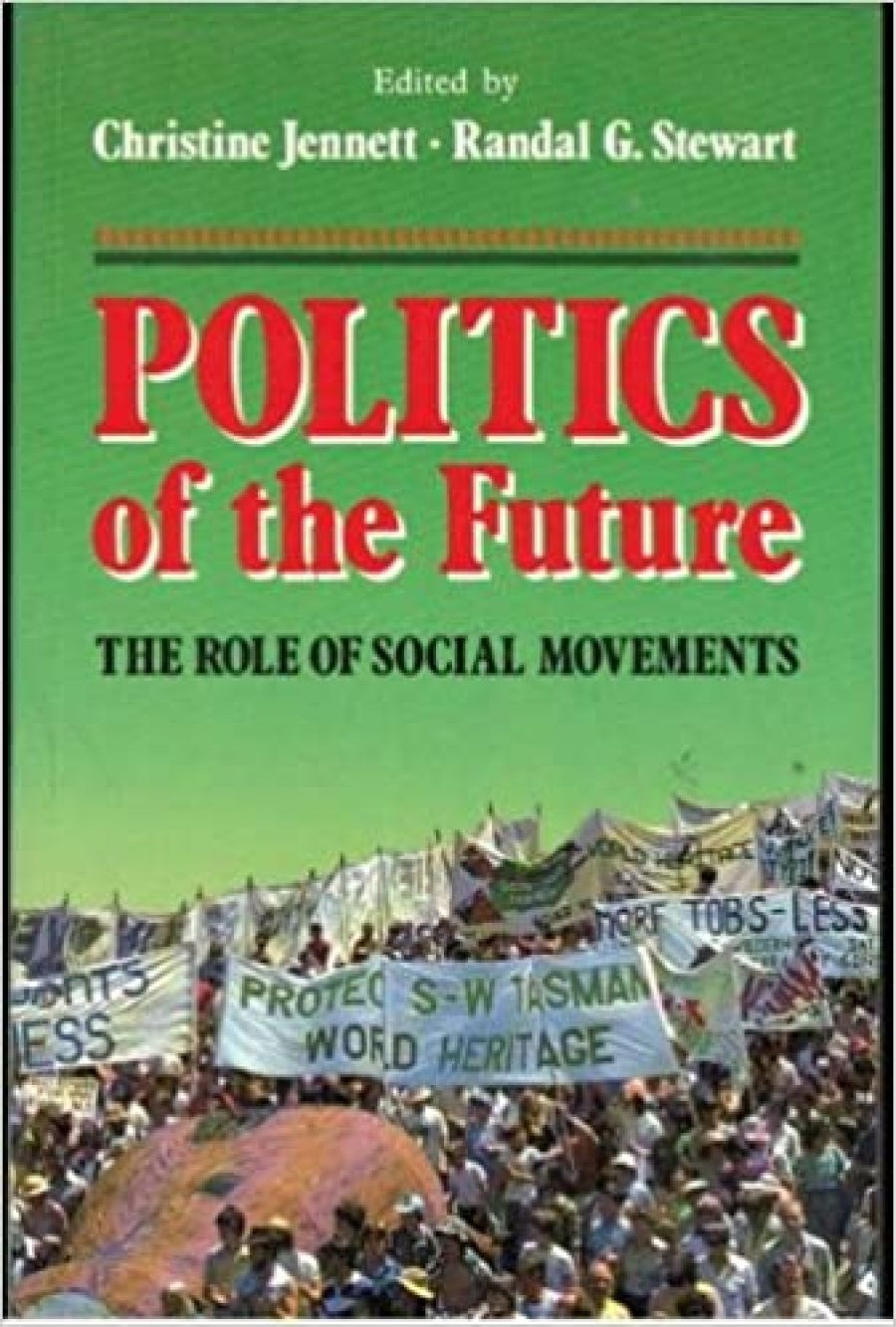
- Free Article: No
- Contents Category: Politics
- Review Article: Yes
- Article Title: The Army of God beside Gay Liberation
- Online Only: No
- Custom Highlight Text:
Twenty years ago there was a fashion in American political science of putting together collections of articles under a generic title such as ‘Political Parties in Developing Nations’. As with so many other American fashions, this spread to Australia and the edited collection is now commonplace in the social sciences. The problem with all such collections, and it applies to this one, is the apples and pears syndrome – not all fruits are the same despite their common classification.
- Book 1 Title: The Politics of the Future
- Book 1 Subtitle: The role of social movements
- Book 1 Biblio: Macmillan, $34.95 pb, 471 pp
At present in Australia, as elsewhere in the developed world, East or West, there is considerable criticism of existing politics and a tendency to look for alternatives. This trend has been analysed in the January 1990 issue of Social Alternatives which, unlike Jennett and Stewart, was lucky enough to catch the events in the Communist world, systems which they do not attempt to cover in their collection. Yet we have seen some of this before in recent history -in 1945, in 1956 and in 1968. Moreover, we see the breakdown of political institutions all the time in the Third World (or the South as Jennett and Stewart call it in a confusing usage for Australians). The impoverished, indebted, poorly organised and fragile alternative movements under which a majority of people live are naturally prone to violent alternative movements as they are to brutal repression. Are they responding to the same discontents as the young and well-educated in the West? One wonders how the gentle Senator Jo Vallentine (who writes on the experience of the Australian nuclear disarmament movement) would go down with the militant Moros of Mindanao (surveyed excellently by Ron May). Or what would the Lebanese Hizbullah (the army of God, described so well by James Piscatori) make of Dennis Altman and Gay Liberation?
The editors and contributors are obviously aware of these problems. They attempt to analyse social movements using the approach of the French political theorist Alain Touraine, who has twenty-eight references in the index compared to only two for someone called Karl Marx. In common with many European radical intellectuals, Touraine looks to social movements alternative to the discredited parties of the Left and the proletariat, as the motor force of social and political change.
Thus all the movements described here (other than, perhaps, the Hizbullah) are on the side of progress. Movements such as Iranian fundamentalism, American militant Protestantism or Serbian nationalism, are not included in the survey. Touraine’ s approach echoes a long European oppositionist tradition, which goes back to French revolutionary Jacobinism. In this tradition attacks on institutions have a positive function of liberating people from the shackles which such institutions impose, shackles rather more obvious in the states built on Marxism or nationalism than those influenced by liberalism. Touraine does not crudely subscribe to the view that progress is inevitable and balances optimistic hopes for change with pessimistic fears of disaster.
Within that broad framework, then, the varied movements surveyed here begin to have some common features, at least in theory. They all question existing social arrangements, whether these are male patriarchy, the Filipino ruling class, the Lebanese Christians, the French colonialists, or the Italian Communist Party. They are led by the young and well-educated, on whom Touraine and many other European intellectuals now place more hopes than on the organised proletariat. They are ‘progressive’ in the sense of wanting more power to the people, a fairer distribution of the world’s goods and the ending of domination over others, whether by classes or by men (the Hizbullah, again, being an exception perhaps). The various movements are, then, ones with which most people brought up in a liberal-radical tradition might be sympathetic. Yet nowhere is there sufficient recognition of the elitism and overt fascism which many mass movements have also espoused -’progressives’ like the Khmer Rouge being no exception. Mass movements may appeal to young radicals precisely because they smash things.
Because the assorted movements looked at are so varied, it is difficult to generalise about quality. If this book is to be used as a teaching text it will need to be put into the hands of someone who understands its rationale and can explain Touraine to Australian students lacking most of the cultural background which European intellectuals assume. The chapters relating directly to Australia are of varied quality. We could have done without Randal Stewart’s rehashing of the old ‘whatever became of ALP socialism?’ theme. Dennis Altman is always worth reading and he sets the Australian gay movement within its international (predominantly American) context. Christine Jennett contributes an interesting piece on the Australian anti-apartheid movement, though I think she errs in assuming its Sydney origins when there was already a movement on a small scale in Melbourne at the time of the Sharpeville shooting in 1961. There is, strangely, nothing on Aborigines.
Colin Rubenstein on Zionism, James Piscatori on the Hizbullah and Ron May on the Mindanao Moros added to my knowledge quite considerably. With Marian Simms on Filipino feminism, Sally Petherbridge on its Pakistani equivalent and Jean Chesneaux on Kanak nationalism, the long section on social movements in the South stands up well as a self-contained unit. But I am still left wondering whether the gentle Greenies and the gun-toting Sandinistas really belong within the same covers.


Comments powered by CComment